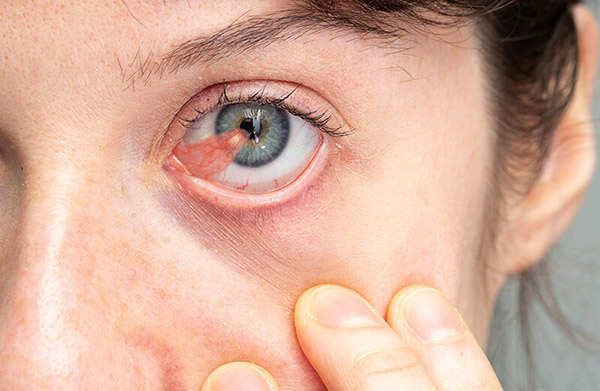Pterygium

Pterygium is a growth on the surface of the eye that can cause discomfort and vision problems. At Inland Valley Surgery Center, we offer specialized care and advanced treatments, including pterygium excision surgery, to effectively address this condition and ensure optimal eye health for our patients.
What is Pteryguym?
A pterygium is an abnormal growth of tissue on the surface of the eye. It appears as a pinkish, fleshy bump that starts from the inner corner of the eye and extends towards the cornea.
If left untreated, it may lead to vision problems. The abnormal growth can encroach onto the cornea, potentially causing astigmatism or distortions in vision.
It can also cause discomfort, redness, irritation, dryness, tearing, and blurred vision. The symptoms may worsen over time as the pterygium grows larger.
It is important to schedule an eye exam with your eye doctor if you notice any abnormal growth on your eye or experience any related symptoms. Your eye doctor can provide a proper diagnosis and recommend appropriate treatment options.
What Causes Pterygium?
The exact cause of pterygium is not fully understood, but several factors are believed to contribute to its development. Excessive exposure to ultraviolet (UV) light, particularly from sunlight, is considered a significant risk factor.
Prolonged exposure to UV radiation can damage the conjunctiva, which is the clear tissue covering the white part of the eye, and trigger the abnormal growth of tissue. In addition to UV light, other environmental factors can play a role.
Dry and dusty environments, as well as exposure to wind and pollutants, may irritate the eyes and contribute to the formation of pterygium. People who spend a lot of time outdoors, such as those involved in outdoor occupations or recreational activities, are more prone to developing pterygium.
Additionally, certain genetic and hereditary factors may make certain people more susceptible to pterygium. While these factors are associated with pterygium, it is important to note that not everyone exposed to them will develop the condition.
How is Pterygium Treated?
Although treatment is not always necessary, the primary treatment for pterygium is surgical removal, known as excision surgery. During this procedure, the abnormal tissue growth is carefully removed from the surface of the eye.
Pterygium excision surgery is typically performed under local anesthesia to numb the eye and reduce discomfort. Your eye surgeon may use various techniques and instruments to remove the pterygium.
In some cases, a conjunctival autograft may be performed. This involves taking a piece of healthy tissue from another part of the eye and transplanting it onto the area where the pterygium was removed.
This graft helps cover the affected area, reducing the chances of recurrence.
What is the Recovery Process After Pterygium Surgery?
After the excision surgery, your eye doctor will give you specific post-operative instructions to facilitate healing and minimize complications. These instructions may involve the use of prescribed eye drops or ointments.
Prescribed medications should be used as instructed to prevent infection and reduce inflammation. Your eye doctor may also place an eye patch or shield over your eye to protect it and aid healing.



